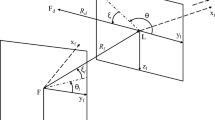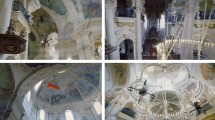Abstract
This paper proposes a new algorithm for controlling a formation of multiple autonomous aerial vehicles based on multiple control objectives. The strategy includes using the null space of a Jacobian matrix to achieve the different control objectives in a non-conflicting way. The mission is split into two elementary tasks, with suitable command references generated for each robot. The commands for each task are combined through a hierarchical method by using the projection of commands onto the null space. The incorporation of ground vehicles in the control scheme is also considered, thus extending the proposed scheme for controlling heterogeneous formations. The stability analysis of the control system shows that such a system is asymptotically stable, and experimental results validate the proposed control system.
Similar content being viewed by others
References
Agnew, M.S., Canto, P.D., Kitts, C.A., Li, S.: Cluster space control of aerial robots. In: International Conference on Advanced Intelligent Mechatronics (IEEE/ASME), pp. 1305–1310, Montral, Canada (2010)
Antonelli, G., Arrichiello, F., Chiaverini, S.: The null-space-based behavioral control for mobile robots. In: IEEE International Symposium on Computational Intelligence in Robotics and Automation (CIRA), pp. 15–20 (2005)
Antonelli, G., Arrichiello, F., Chiaverini, S.: The null-space-based behavioral control for autonomous robotic systems. Intell. Serv. Robot. 1(1), 27–39 (2008)
Antonelli, G., Arrichiello, F., Chiaverini, S.: Experiments of formation control with multirobot systems using the null-space-based behavioral control. IEEE Trans. Control Syst. Technol. 17(5), 1173–1182 (2009)
Antonelli, G., Chiaverini, S.: Kinematic control of platoons of autonomous vehicles. IEEE Trans. Robot. 22(6), 1285–1292 (2006)
Balch, T., Arkin, R.: Behavior-based formation control for multirobot teams. IEEE Trans. Robot. Autom. 14(6), 926–939 (1998)
Brandao, A.S., Rampinelli, V.T.L., Martins, F.N., Sarcinelli-Filho, M., Carelli, R.: The multilayer control scheme: A strategy to guide n-robots formations with obstacle avoidance. J. Control Autom. Electr. Syst. 26(3), 201–214 (2015)
Carelli, R.O., Roberti, F., Tosetti, S.: Direct visual tracking control of remote cellular robots. Robot. Auton. Syst. 54(10), 805–814 (2006)
Chen, J., Sun, D., Yang, J., Chen, H.: Leader-follower formation control of multiple non-holonomic mobile robots incorporating a receding-horizon scheme. Int. J. Robot. Res. 29(6), 727–747 (2010)
Consolini, L., Morbidi, F., Prattichizzo, D., Tosques, M.: Leader-follower formation control of nonholonomic mobile robots with input constraints. Automatica 40(5), 1343–1349 (2008)
Kitts, C.A., Mas, I.: Cluster space specification and control of mobile multirobot systems. IEEE/ASME Trans. Mechatron. 14(2), 207–218 (2009)
Liu, J., Wu, J.: Multiagent Robotic Systems. CRC Press (2001)
Park, J., Choi, Y., Chung, W.K., Youm, Y.: Multiple tasks kinematics using weighted pseudo-inverse for kinematically redundant manipulators. In: Proceedings of the 2001 IEEE International Conference on Robotics and Automation (ICRA’01), pp. 4041–4047, Seoul, Korea (2001)
Rosales, C., Gandolfo, D., Scaglia, G., Jordan, M., Carelli, R.: Trajectory tracking of a mini four-rotor helicopter in dynamic environments - a linear algebra approach. Robotica FirstView, 1–25 (2014). doi:10.1017/S0263574714000952
Santana, L.V., Brandao, A.S., Sarcinelli-Filho, M., Carelli, R.: A trajectory tracking and 3d positioning controller for the ar.drone quadrotor. In: 2014 International Conference on Unmanned Aircraft Systems (ICUAS’14), pp. 756–767 (2014)
Scharf, D., Hadaegh, F., Ploen, S.: A survey of spacecraft formation flying guidance and control (part ii): Control. In: American Control Conference, pp. 2976–2985, Massachusetts, USA (2004)
Slabaugh, G.G.: Computing euler angles from a rotation matrix. Technical Reports (1999)
Tanner, H., Pappas, G., Kumar, V.: Leader-to-formation stability. IEEE Trans. Robot. Autom. 20(3), 443–455 (2004)
Zhang, Y., Mehrjerdi, H.: A survey on multiple unmanned vehicles formation control and coordination: normal and fault situations. In: International Conference on Unmanned Aircraft Systems (ICUAS), pp. 1087–1096, GA, USA (2013)
Author information
Authors and Affiliations
Corresponding author
Rights and permissions
About this article
Cite this article
Rosales, C., Leica, P., Sarcinelli-Filho, M. et al. 3D Formation Control of Autonomous Vehicles Based on Null-Space. J Intell Robot Syst 84, 453–467 (2016). https://doi.org/10.1007/s10846-015-0329-5
Received:
Accepted:
Published:
Issue Date:
DOI: https://doi.org/10.1007/s10846-015-0329-5




